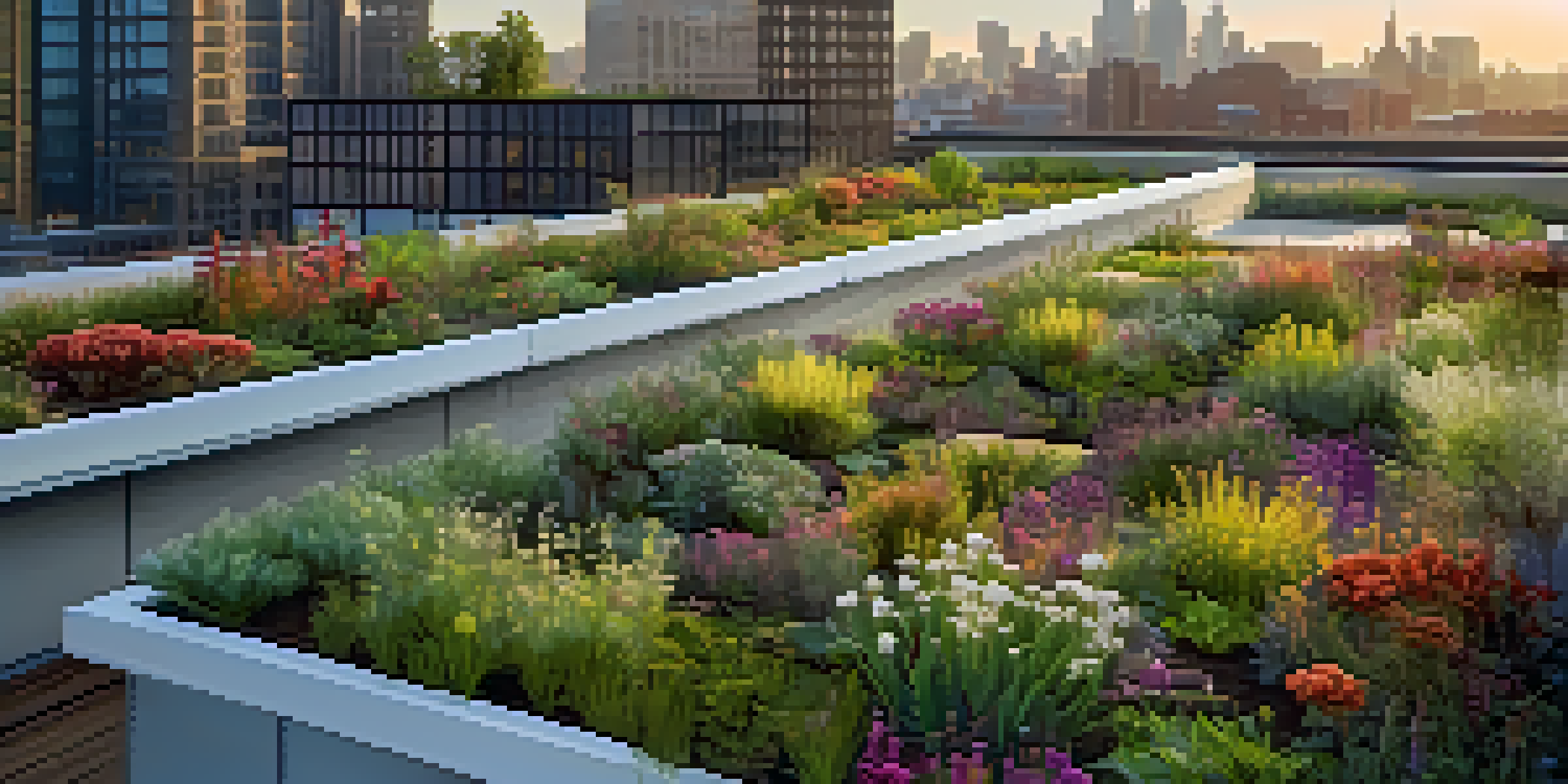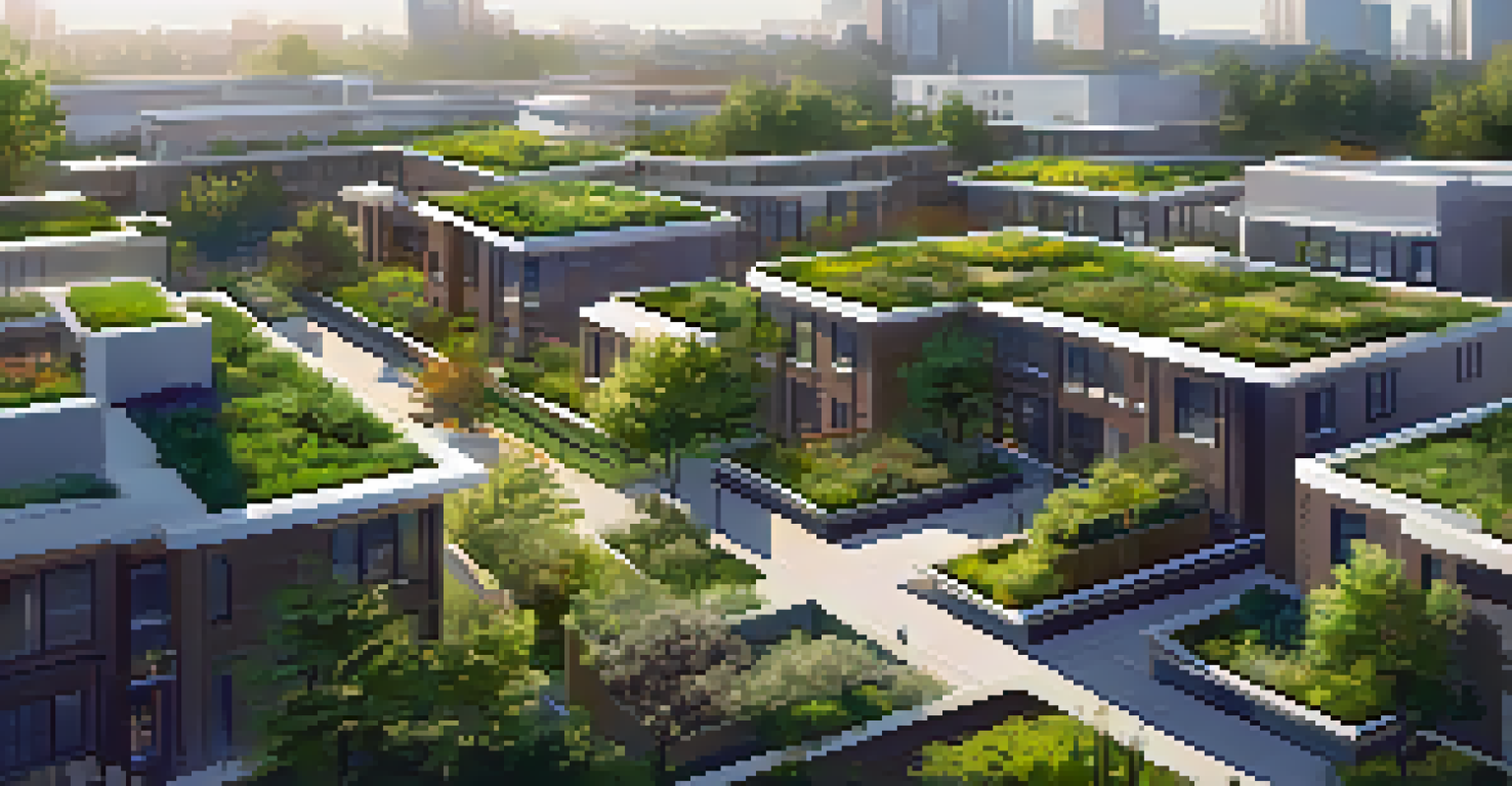Green Roofs: A Sustainable Choice for Urban Homes

What Are Green Roofs and How Do They Work?
Green roofs are essentially gardens planted on rooftops, turning underutilized spaces into lush environments. They consist of layers that include a waterproof membrane, a drainage system, soil, and plants. This unique setup not only enhances aesthetics but also improves insulation, helping to regulate indoor temperatures.
Green roofs are a vital part of a sustainable urban environment, providing ecological benefits while enhancing the quality of life for city residents.
Imagine stepping onto your rooftop and finding a vibrant garden instead of just concrete. This transformation can create a calming atmosphere right in the heart of bustling cities. Moreover, green roofs can absorb rainwater, reducing runoff and decreasing flood risks in urban areas.
In essence, green roofs are a perfect blend of nature and innovation, offering a sustainable solution to urban challenges. They're not just a trend; they are a functional way to integrate greenery into our environments, making cities more livable and enjoyable.
Environmental Benefits of Green Roofs
One of the most significant advantages of green roofs is their impact on the environment. They can help reduce the urban heat island effect, where cities become significantly warmer than surrounding areas due to human activities. By providing a natural cooling effect, green roofs can lower energy consumption for air conditioning.

Additionally, green roofs play a crucial role in improving air quality. Plants absorb carbon dioxide and release oxygen, creating cleaner air for city dwellers. This is especially important in urban areas, where pollution levels can be high and detrimental to health.
Green Roofs Enhance Urban Living
Green roofs transform rooftops into vibrant gardens, improving aesthetics and indoor temperatures while managing rainwater.
Moreover, these roofs can serve as habitats for various species, promoting biodiversity in otherwise concrete-dominated landscapes. By incorporating more greenery, we not only beautify our surroundings but also contribute to a healthier ecosystem.
Economic Advantages of Installing Green Roofs
Investing in a green roof can lead to substantial long-term savings. While the initial cost might be higher than traditional roofing, the energy efficiency gained can lead to lower utility bills. Over time, the savings can offset the installation costs, making them a financially sound choice.
The future of urban living lies in our ability to integrate nature into our cities, and green roofs are a perfect example of this principle in action.
Moreover, green roofs can increase property values. As more people become environmentally conscious, homes with green roofs often stand out in the real estate market. They offer potential buyers not just a home but a lifestyle that prioritizes sustainability.
Additionally, many local governments offer incentives for green roof installations, such as tax breaks or grants. These financial benefits can significantly ease the cost of installation, making the sustainable choice even more appealing.
Designing Your Green Roof: Key Considerations
When planning a green roof, the first step is to consider the structure's weight capacity. Not all roofs can support the additional weight of soil and plants, so a thorough evaluation with a professional is essential. This ensures that your green roof is safe and sustainable.
Next, think about the types of plants you want to include. Choosing native plants that thrive in your local climate can reduce maintenance and irrigation needs. Additionally, a diverse selection of plants can create a beautiful and vibrant space that attracts pollinators like bees and butterflies.
Environmental and Economic Benefits
They reduce the urban heat island effect, improve air quality, and can lead to significant long-term savings on energy bills.
Finally, consider how you want to use the space. Will it be a private garden retreat, a community space, or a combination of both? Designing with purpose can enhance your experience and maximize the benefits of your green roof.
Maintenance Tips for Green Roofs
Maintaining a green roof doesn't have to be a daunting task. Most green roofs require minimal upkeep, particularly if you've chosen drought-resistant plants. Regular checks for drainage and ensuring that plants are healthy can go a long way in preserving your green oasis.
It's also beneficial to establish a seasonal maintenance routine. For instance, during spring, you can inspect for any dead or damaged plants and replace them as needed. In fall, consider cleaning debris to prevent any blockages in the drainage system.
Remember, even though green roofs are designed to be low-maintenance, they still benefit from occasional care. A little attention can keep your roof thriving, ensuring that it remains a beautiful and functional part of your home.
Real-Life Examples of Successful Green Roofs
Cities around the world are embracing green roofs, showcasing their benefits. For example, the Chicago City Hall boasts a stunning green roof that not only reduces energy costs but also serves as a community space for educational programs. This initiative has inspired many other urban developments to follow suit.
In Germany, where green roofs are more common, cities like Hamburg have integrated them into their urban planning. These roofs are used to manage stormwater and improve air quality, reflecting a commitment to sustainability that other cities are starting to adopt.
Successful Green Roof Examples
Cities like Chicago and Hamburg showcase successful green roofs that contribute to sustainability and community well-being.
Such examples highlight that green roofs are more than just a trend; they are becoming an integral part of urban infrastructure, leading the way toward greener cities. Seeing these successful implementations can motivate homeowners to consider how they can contribute to this sustainable movement.
Getting Started with Your Green Roof Project
If you're ready to embark on your green roof journey, the first step is to consult with a professional. They can guide you through the design process, ensuring your roof meets all structural requirements and zoning regulations. This foundational planning is crucial for a successful installation.
Next, consider your budget and potential funding options. Research local grants or incentives that may be available for green roof projects. Understanding the financial landscape can help you make informed decisions and possibly save money.

Finally, engage with your community. Sharing your plans and involving neighbors can create a supportive network and inspire others to consider similar projects. Together, you can contribute to a greener urban environment, making your community more vibrant and sustainable.